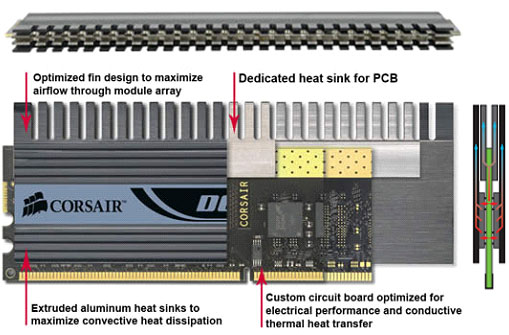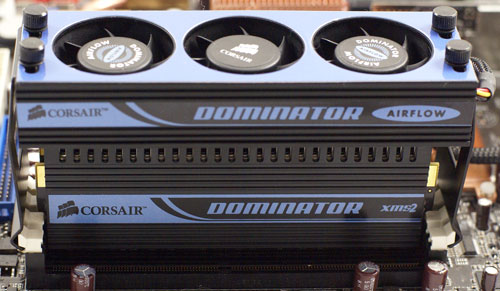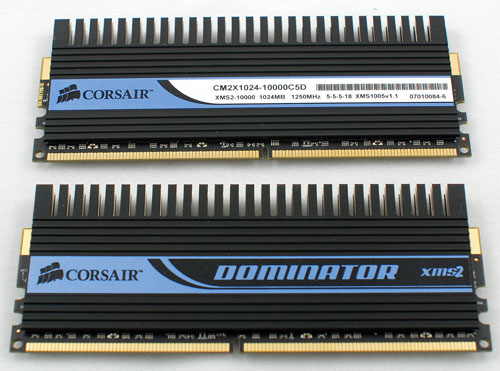Corsair Dominator PC2-10000: Fastest DDR2
by Wesley Fink on January 31, 2007 2:00 AM EST- Posted in
- Memory
Corsair Dominator Twin2x2048-10000C5DF
Memory from Corsair is widely distributed around the world. This makes the Corsair brand the most recognized brand of enthusiast memory. It is easy to find just about anywhere you might be located. Corsair has been manufacturing high-speed memory since 1994. They maintain an extensive line of memory, ranging from their Value Select brand of low-cost memory to their top-end XMS line.
Corsair is well known as an innovator in the high performance memory market. As a result they enjoy a large and loyal customer base. The new PC2-10000 represents a new record in rated memory speed, but it achieves this with technology introduced with the Dominator series. As the flag ship of the Corsair memory line, the XMS2 Dominator brings many unique innovations in the PCB and memory cooling. One of the most unusual Dominator features is the dual-path cooling, which Corsair calls DHX, or Dual Heat Exchange.

Dominator modules use two paths for memory cooling:

Here you see the extended Dominator circuit board with a conventional heatsink. The inner fins, which cool the board and the back of the chips, are sealed to the top of the Dominator circuit board. The front Dominator heatsinks also have cooling fins at the top. After they are sealed to the memory chips the Dominator module has four sets of cooling fins - two inner fins and two outer cooling fins. Cooling can be further enhanced with a Dominator Airflow fan. This super-efficient fan is designed to attach to the memory clips and float over the Dominator memory modules.

The Dominator modules with the attached Dominator Airflow fan are an imposing site. The fan module uses three 40mm tachometer controlled fans that run at moderate speed to provide adequate airflow but still remain near silent when operating. The Dominator Airflow fan kit comes standard with the Dominator PC2-10000 2GB memory kit, but it is also an optional accessory that will work with any DDR2 or DDR memory kits to provide additional cooling. The attachment method is universal, since the Airflow fan attaches to the memory clips and plugs into the mother board.

Corsair supplies Dominator DDR2-1250 in a box about the size of a package for a video card. The box contains a matched pair of 1GB Dominator DIMMs and a Dominator Airflow fan unit.

The PC2-10000 Dominator DIMMs are built with specially binned Micron D DDR2 memory chips. This is certainly not a surprise since OCZ Flex XLC and all the other recently tested top-of-the-line memory has used the same memory chips.
The Corsair Dominator RAM fit all of the DDR2 slots on our test motherboards. While it is thicker than most past DDR2 memory, the dual-path heat exchanger still fits fine in standard DDR2 slots. Dominator DIMMs are taller than most other DIMMs, however, due to the four rows of protruding cooling fins at the top. The Dominator Airflow fan makes the complete setup even taller, but we had no trouble fitting the Dominator 10000 kit in any standard case. Since the Airflow fan occupies the same area as the memory module area, fan space requirements are actually less than a large fan resting on top of the DIMMs. We have had no problem at all using a complete Dominator kit with the large Tuniq 120 Tower air cooling system.
Memory from Corsair is widely distributed around the world. This makes the Corsair brand the most recognized brand of enthusiast memory. It is easy to find just about anywhere you might be located. Corsair has been manufacturing high-speed memory since 1994. They maintain an extensive line of memory, ranging from their Value Select brand of low-cost memory to their top-end XMS line.
Corsair is well known as an innovator in the high performance memory market. As a result they enjoy a large and loyal customer base. The new PC2-10000 represents a new record in rated memory speed, but it achieves this with technology introduced with the Dominator series. As the flag ship of the Corsair memory line, the XMS2 Dominator brings many unique innovations in the PCB and memory cooling. One of the most unusual Dominator features is the dual-path cooling, which Corsair calls DHX, or Dual Heat Exchange.

Dominator modules use two paths for memory cooling:
- Conventional heat release through the front of the memory chips into a pair of super efficient heat sinks
- Additional heat dissipation through the back of the chips and through the circuit board through heat fins integral to the PCB.

Here you see the extended Dominator circuit board with a conventional heatsink. The inner fins, which cool the board and the back of the chips, are sealed to the top of the Dominator circuit board. The front Dominator heatsinks also have cooling fins at the top. After they are sealed to the memory chips the Dominator module has four sets of cooling fins - two inner fins and two outer cooling fins. Cooling can be further enhanced with a Dominator Airflow fan. This super-efficient fan is designed to attach to the memory clips and float over the Dominator memory modules.

The Dominator modules with the attached Dominator Airflow fan are an imposing site. The fan module uses three 40mm tachometer controlled fans that run at moderate speed to provide adequate airflow but still remain near silent when operating. The Dominator Airflow fan kit comes standard with the Dominator PC2-10000 2GB memory kit, but it is also an optional accessory that will work with any DDR2 or DDR memory kits to provide additional cooling. The attachment method is universal, since the Airflow fan attaches to the memory clips and plugs into the mother board.

Corsair supplies Dominator DDR2-1250 in a box about the size of a package for a video card. The box contains a matched pair of 1GB Dominator DIMMs and a Dominator Airflow fan unit.

The PC2-10000 Dominator DIMMs are built with specially binned Micron D DDR2 memory chips. This is certainly not a surprise since OCZ Flex XLC and all the other recently tested top-of-the-line memory has used the same memory chips.
| Corsair Dominator Twin2x2048-10000C5DF Memory Specifications |
|
| Number of DIMMs & Banks | 2 DS |
| DIMM Size | 1GB |
| Total Memory | 2 GB |
| Rated Timings | 5-5-5-18 at DDR2-1250 |
| Rated Voltage | 2.4V |
The Corsair Dominator RAM fit all of the DDR2 slots on our test motherboards. While it is thicker than most past DDR2 memory, the dual-path heat exchanger still fits fine in standard DDR2 slots. Dominator DIMMs are taller than most other DIMMs, however, due to the four rows of protruding cooling fins at the top. The Dominator Airflow fan makes the complete setup even taller, but we had no trouble fitting the Dominator 10000 kit in any standard case. Since the Airflow fan occupies the same area as the memory module area, fan space requirements are actually less than a large fan resting on top of the DIMMs. We have had no problem at all using a complete Dominator kit with the large Tuniq 120 Tower air cooling system.










22 Comments
View All Comments
OBWan - Wednesday, November 14, 2007 - link
It appears that the "highest memory speed" chart on page 7 is not an objective comparison. Besides the top 3 bars that were tested with the overclock-friendly 680i platform, all the rest were tested with old chipsets e.g. 975X. The old chipsets actually hindered the max overclocking potential of those other DDR2's while at the time of their reviews, the editors believed those DDR2's had reached their speed limit, which was an unsighted mistake. So please delete this biased comparison chart and re-do all the tests with the same 680i platform. The readers in this forum deserve not to be cheated.yacoub - Thursday, February 1, 2007 - link
If those timings relax much more, they'll be asleep.5-5-5-18? hehe =)
phil verhey - Thursday, February 1, 2007 - link
i had buffalo pc2-10000 3.5 months ago.. and i still overclocked it to 1300mhz at 5-5-5-18 .. talk about an either ignorant, or biased article.Wesley Fink - Friday, February 2, 2007 - link
The Buffalo 10000 was announced in Japan a couple of months ago, and it was widely reported that DDR2-1200 and DDR2-1250 were "coming". We have reviewed Buffalo memory in the past and we have yet to receive Buffalo PC2-10000 samples for review. We also have not seen a single review of Buffalo PC2-10000. PC2-10000 is also not listed on the Buffalo website - the highest rated Firestix there are PC2-8500.The Corsair PC2-10000 is a production product with warranted PC2-10000 performance. We ALSO reached DDR2-1300 and DDR2-1315 several months ago, with OCZ and Corsair, but neither product wass rated or warranted at PC2-10000.
I have no doubt the Buffalo PC2-10000 is likely a good product. It is just we have neither seen or received for testing Buffalo PC2-10000 - we have only seen press announcements.
VooDooAddict - Wednesday, January 31, 2007 - link
I'd like you to also show a zero based benchmark graph. I understand that you mention it in the article ... but too many people will just look at the graphs. Budget focused people also should see how little going down to 667 or even 533 effects the performance (I try to steer people to 800 just for a little more future proofing of their memory investment).I'm sick of people requesting this absurdly expensive RAM. I've got not problem people requesting the RAM for over clocking, the good looking cooler mods, or the brand name... but people are still requesting this stuff because they expect much better performance.
I can make my own Zero based graph based on your numbers to show people ... but I'm much rather direct them to the original source.
Wesley Fink - Wednesday, January 31, 2007 - link
The explanation is bold and tells readers why we show a limited range. It is difficult enough to pick out memory variations in a reduced range chart, and it would be almost impossible in a zero-based chart. We also clearly state results on a zero-based chart would show little variation in performance at different speeds.In the conclusion I was also very clear:
"There is also the reality that Core 2 Duo and AM2 really don't need the highest memory speeds to perform best. What they need is low latency DDR2-800 or possibly 4-4-3 DDR2-1067 to get the best performance possible. The unfortunate reality that we see again and again in memory tests is that the super high memory speeds are great for bragging rights and flexible overclocking, but they really don't do much for increasing actual real world performance on either the C2D or AM2 platforms.
Memory companies seem obsessed right now with higher and higher DDR2 memory speeds... We wish memory companies would become just as obsessed with producing a moderately priced 2 GB DDR2-800 kit that can perform day in and day out at 3-3-3 timings. It would be a bonus if it also overclocked to DDR2-1067 with 4-4-4 timings. With Vista performing best with 2GB of memory many will be upgrading memory as they move to the new OS. Whoever finally produces a reasonably-priced low latency DDR2-800 2GB kit will sell all they can produce."
We are reviewing super high-end memory that is a good choice for some buyers, like overclocking enthusiasts, but they are a waste of money for the average buyer. We definitely agree once you get above 800 on C2D or AM2 there is very little gain in performance. Your money is better spent on a faster processor or an upgraded video card.
Live - Thursday, February 1, 2007 - link
If there is no real world difference then why do you state in your buying guides that it is important to keep a 1:1 ratio?From the January 2007 Buyer's Guide: Midrange Menagerie
This is not the only example. You seem to do this in all your memory reviews I have read lately as well. Granted they have been of high end memory and it seems unreasonable to spend that much on memory if you weren’t looking for the absolute maximum speeds. I still don’t understand tough why a 1:1 ratio is good for overclocking. It would seems to me that by lowering your memory ratio you could reach higher CPU overclocks cheaper which is what really matters, no? I mean most overclock as a way to save money not get the WR in superPI.
The thing is for us that don't work with this everyday it’s hard to keep up and not fall for the aggressive marketing. I would appreciate it if you could devote a little more time to steer us right without breaking the bank. I know it’s probably not as fun but it would be much appreciated by us readers.
Neosis - Sunday, February 4, 2007 - link
I think additional latencies shall arise at chipset level. Generally following stages take place while requesting data from memory:1- Data Request from CPU thru. the FSB
2- Chipset transfer the request to memory from FSB
3- Memory responds to the request
4- Chipset then trasfer the request from the memory thru. FSB
5- Finally the requested data travels across the FSB to the CPU
In stage two and four, running the memory asynchronous to the FSB will increase latency. Since conroe has short pipeline like Amd, memory latency is more important than the memory bandwidth.
tayhimself - Wednesday, January 31, 2007 - link
Sorry but that is a piss poor excuse. Its like published scientific studies saying, "we use this statistical analysis because its the only one that shows a significant difference". Who the hell would buy drugs based on that premise. Piss poor AT!!thudo - Wednesday, January 31, 2007 - link
Conroe E6700 @ 3.66Ghz (1.53V) || Scythe Mine CPU Cooler + ArcticSilver5 Thermal Paste || OCZ 2gb PC8000 DC EL GEEK RAM || Asus P5W DH Mobo (1301 Bios) || EVGA 8800GTX ACS3 Cooling Edition (659/1013) || 2x10k Rpm WD SATA2 Raptor HDDs || Thermaltake Armour Full Tower w/side 250mm Mobo Case Fan || OCZ GamerX 700W PSU || WinXP+ SP2 + DX9c + All Updates || Latest Nvidia Forceware (97.x) || 3dmark2006 Score: 12,426 || SiSandra Int Buff'd iSSE2 : 7561 MB/s // Float Buff'd iSSE2 : 7562 MB/sStill surprised my box beats out the latest ram with the Overclock. Can only imagine having the new ram overclocked on the beat! :O